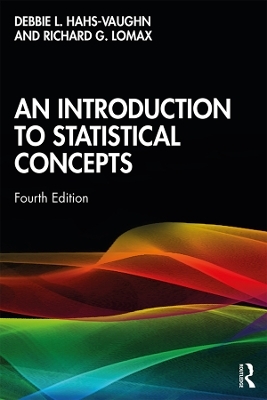
An Introduction to Statistical Concepts
Routledge (Verlag)
978-1-138-65055-8 (ISBN)
The new edition of An Introduction to Statistical Concepts is designed to help students really understand statistical concepts, the situations in which they can be used, and how to apply them to data.
Hahs-Vaughn and Lomax discuss the most popular, along with many of the lesser-known, procedures and models, whilst also exploring nonparametric procedures used when standard assumptions are violated. They provide in-depth coverage of testing assumptions and highlight several online tools for computing statistics (e.g., effect sizes and their confidence intervals and power). This comprehensive, flexible, and accessible text includes a new chapter on mediation and moderation; expanded coverage of effect sizes; and discussions of sensitivity, specificity, false positive, and false negative, along with using the receiver operator characteristic (ROC) curve. In addition to instructions and screen shots for using SPSS, new to this edition is annotated script for using R.
This book, noted for its crystal-clear explanations, and its inclusion of only the most crucial equations, is an invaluable resource for students undertaking a course in statistics in any number of social science and behavioral disciplines—from education, business, communication, exercise science, psychology, sociology and more.
Debbie L. Hahs-Vaughn is Professor of Methodology, Measurement, and Analysis at the University of Central Florida, US. Her primary research interest relates to methodological issues associated with applying quantitative statistical methods to survey data obtained under complex sampling designs and using complex survey data to answer substantive research questions. Richard G. Lomax is Professor Emeritus of Educational and Human Ecology at the Ohio State University, US, and former Associate Dean for Research and Administration. His research primarily focuses on early literacy and statistics.
Preface
Acknowledgements
1. INTRODUCTION
2. DATA REPRESENTATION
3. UNIVARIATE POPULATION PARAMETERS AND SAMPLE STATISTICS
4. THE NORMAL DISTRIBUTION AND STANDARD SCORES
5. INTRODUCTION TO PROBABILITY AND SAMPLE STATISTICS
6. INTRODUCTION TO HYPOTHESIS TESTING: INFERENCES ABOUT A SINGLE MEAN
7. INFERENCES ABOUT THE DIFFERENCE BETWEEN TWO MEANS
8. INFERENCES ABOUT PROPORTIONS
9. INFERENCES ABOUT VARIANCES
10. BIVARIATE MEASURES OF ASSOCIATION
11. ONE-FACTOR ANALYSIS OF VARIANCE – FIXED-EFFECTS MODEL
12. MULTIPLE COMPARISON PROCEDURES
13. FACTORIAL ANALYSIS OF VARIANCE – FIXED-EFFECTS MODEL
14. INTRODUCTION TO ANALYSIS OF COVARIANCE: THE ONE-FACTOR FIXED-EFFECTS MODEL WITH A SINGLE COVARIATE
15. RANDOM- AND MIXED-EFFECTS ANALYSIS OF VARIANCE MODELS
16. HIERARCHICAL AND RANDOMIZED BLOCK ANALYSIS OF VARIANCE MODELS
17. SIMPLE LINEAR REGRESSION
18. MULTIPLE LINEAR REGRESSION
19. LOGISTIC REGRESSION
20. MEDIATION AND MODERATION
Appendix: Tables
| Erscheinungsdatum | 09.01.2020 |
|---|---|
| Zusatzinfo | 249 Tables, black and white; 127 Line drawings, black and white; 267 Halftones, black and white |
| Verlagsort | London |
| Sprache | englisch |
| Maße | 178 x 254 mm |
| Gewicht | 2254 g |
| Themenwelt | Geisteswissenschaften ► Psychologie ► Allgemeine Psychologie |
| Sozialwissenschaften ► Pädagogik ► Erwachsenenbildung | |
| Sozialwissenschaften ► Soziologie ► Empirische Sozialforschung | |
| Wirtschaft ► Volkswirtschaftslehre | |
| ISBN-10 | 1-138-65055-2 / 1138650552 |
| ISBN-13 | 978-1-138-65055-8 / 9781138650558 |
| Zustand | Neuware |
| Informationen gemäß Produktsicherheitsverordnung (GPSR) | |
| Haben Sie eine Frage zum Produkt? |
aus dem Bereich


